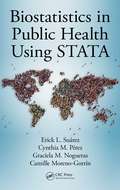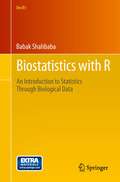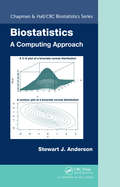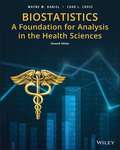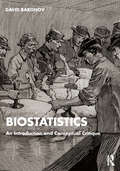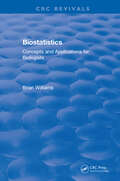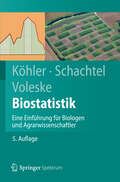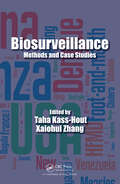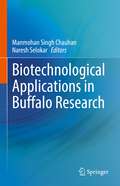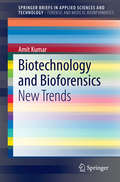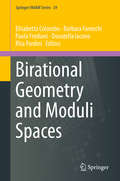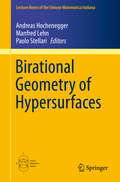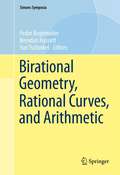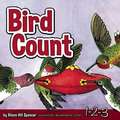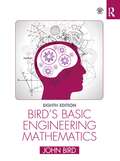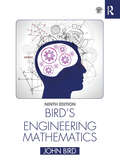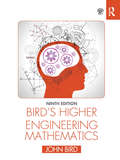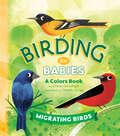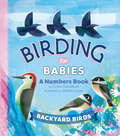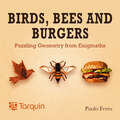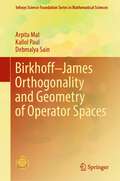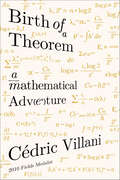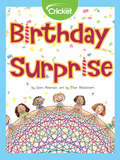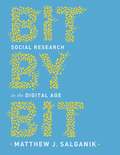- Table View
- List View
Biostatistics in Public Health Using STATA
by Cynthia M. Pérez Erick L. Suárez Graciela M. Nogueras Camille Moreno-GorrínStriking a balance between theory, application, and programming, Biostatistics in Public Health Using STATA is a user-friendly guide to applied statistical analysis in public health using STATA version 14. The book supplies public health practitioners and students with the opportunity to gain expertise in the application of statistics in epidemiolo
Biostatistics with R: An Introduction to Statistics Through Biological Data (Use R!)
by Babak ShahbabaBiostatistics with R is designed to mimic the interaction between theory and application in statistics. Topics include data exploration, estimation, and clustering with two appendices on installing and running R and R-commander.
Biostatistics: A Computing Approach (Chapman & Hall/CRC Biostatistics Series)
by Stewart AndersonThe emergence of high-speed computing has facilitated the development of many exciting statistical and mathematical methods in the last 25 years, broadening the landscape of available tools in statistical investigations of complex data. Biostatistics: A Computing Approach focuses on visualization and computational approaches associated with both mo
Biostatistics: A Foundation For Analysis In The Health Sciences
by Wayne W. Daniel Chad L. CrossThe ability to analyze and interpret enormous amounts of data has become a prerequisite for success in allied healthcare and the health sciences. Now in its 11th edition, Biostatistics: A Foundation for Analysis in the Health Sciences continues to offer in-depth guidance toward biostatistical concepts, techniques, and practical applications in the modern healthcare setting. Comprehensive in scope yet detailed in coverage, this text helps students understand—and appropriately use—probability distributions, sampling distributions, estimation, hypothesis testing, variance analysis, regression, correlation analysis, and other statistical tools fundamental to the science and practice of medicine.
Biostatistics: An Introduction and Conceptual Critique
by David BaronovWithout question, biostatistical analysis has contributed to a slew of amazing medical breakthroughs. Yet it also distorts and deforms the holistic and contingent nature of health and medicine. How is it that biostatistics can both sharpen and weaken our understanding of health and medicine? What is unique about the content of health and medicine that so plainly reveals such distortions and deformities? Exploring these questions entails, first, a full survey of the tools and techniques of biostatistical analysis aiding medical breakthroughs. This survey must then be paired with a probe into the conceptual premises of these tools and techniques and how they refashion and reconstitute the inherently qualitative content of health and medicine in preparation for its quantification. We must grasp the statistical machinations at play, both technical and conceptual, that contrive to fit objects to tools rather than fitting tools to objects. This textbook introduces both the procedural methods and the hidden premises of biostatistical analysis.
Biostatistics: Concepts and Applications for Biologists (CRC Press Revivals)
by Brian WilliamsThis book is a first course in statistics for students of biology. Most of the examples have an ecological bias, but illustrate principles which have direct relevance for biologists doing laboratory work. The structured approach begins with basic concepts, and progresses towards an appreciation of the needs and use of analysis of variance and regression, and includes the use of computer statistical packages. The work is clearly explained with worked examples of real-life biological problems, and should be suitable for undergraduate students engaged in quantitative biological work. Biostatistics should give students a sound grasp of the key principles of biological statistics without overwhelming detail, and should allow students to quickly apply techniques to their own work and data.
Biostatistik: Eine Einführung für Biologen und Agrarwissenschaftler (Springer-Lehrbuch)
by Gabriel Schachtel Peter Voleske Wolfgang KöhlerDie Auswertung experimenteller Ergebnisse ist für Biologen und Agrarwissenschaftler ein wichtiges Handwerkszeug. Mit dieser gut verständlichen Einführung in Grundlagen und Anwendungen der Biometrie ist ein schneller Einstieg in die Statistik möglich. Soweit wie möglich wird ohne Formeln und mathematische Symbolik die hinter den Verfahren stehende Grundidee komplexer statistischer Verfahren erläutert. Die 5. Auflage enthält zusätzlich Schemata zur Versuchsplanung und Auswertung sowie ein erweitertes Glossar englischer Fachausdrücke.
Biosurveillance: Methods and Case Studies
by Taha Kass-Hout Xiaohui ZhangAs evidenced by the anthrax attacks in 2001, the SARS outbreak in 2003, and the H1N1 influenza pandemic in 2009, a pathogen does not recognize geographic or national boundaries, often leading to devastating consequences. Automated biosurveillance systems have emerged as key solutions for mitigating current and future health-related events. Focusing
Biotechnological Applications in Buffalo Research
by Manmohan Singh Chauhan Naresh SelokarThis book comprehensively reviews the advancements in biotechnological applications for the enhanced production and conservations of buffalo (Bubalus bubalis). The book discusses developments in assisted reproduction to improve productivity and the produce novel products for applications to human health and nutrition. The initial chapters of the book discuss the global distribution and domestications of buffalo, and nutritive values of buffalo milk, while the subsequent sections examine the applications of the genome-wide association traits to identify potential genetic variants affecting important economic traits. It identifies predictive biomarkers for postpartum or peripartum diseased-state and presents potential protein biomarkers for the diagnosis of early pregnancy in buffalo. Lastly, it discusses recent scientific developments such as induced pluripotent stem cells, spermatogonial stem cells, somatic cell nuclear transfer, and buffalo as a model for human biomedical research. This book is a useful source to students, academicians, researchers, and policymakers who are involved in buffalo science and industry.
Biotechnology and Bioforensics: New Trends (SpringerBriefs in Applied Sciences and Technology)
by Amit KumarThis Brief covers broad areas of Applied Biology specifically into the domains of Biotechnology/Biomedicine and Forensic Science. Chapters included here would also explain the role of bioinformatics in protein and gene characterization, modeling of the protein structure, survey related to the chromosomal effect on Human Disorders like Diabetes and Cardiac Problems. This Brief is full of Innovative Literature like Use of Microbes in Electricity Production, Brain connection to Type 2 Diabetes etc. Interesting issues in Forensic biology and the aspects of Bioforensics like STR profiling of exhumed bones makes this brief truly useful and informative for Researchers. It also includes the advancements and new ideologies in understanding crop improvements & crop quality. This Brief witnesses Innovative Research related to the Bio and Agri software development too which are capable of accelerating Insilico biological data analysis.
Birational Geometry and Moduli Spaces (Springer INdAM Series #39)
by Rita Pardini Elisabetta Colombo Barbara Fantechi Paola Frediani Donatella IaconoThis volume collects contributions from speakers at the INdAM Workshop “Birational Geometry and Moduli Spaces”, which was held in Rome on 11–15 June 2018. The workshop was devoted to the interplay between birational geometry and moduli spaces and the contributions of the volume reflect the same idea, focusing on both these areas and their interaction. In particular, the book includes both surveys and original papers on irreducible holomorphic symplectic manifolds, Severi varieties, degenerations of Calabi-Yau varieties, uniruled threefolds, toric Fano threefolds, mirror symmetry, canonical bundle formula, the Lefschetz principle, birational transformations, and deformations of diagrams of algebras. The intention is to disseminate the knowledge of advanced results and key techniques used to solve open problems. The book is intended for all advanced graduate students and researchers interested in the new research frontiers of birational geometry and moduli spaces.
Birational Geometry of Foliations (IMPA Monographs #1)
by Marco BrunellaThe text presents the birational classification of holomorphic foliations of surfaces. It discusses at length the theory developed by L. G. Mendes, M. McQuillan and the author to study foliations of surfaces in the spirit of the classification of complex algebraic surfaces.
Birational Geometry of Hypersurfaces: Gargnano del Garda, Italy, 2018 (Lecture Notes of the Unione Matematica Italiana #26)
by Paolo Stellari Andreas Hochenegger Manfred LehnOriginating from the School on Birational Geometry of Hypersurfaces, this volume focuses on the notion of (stable) rationality of projective varieties and, more specifically, hypersurfaces in projective spaces, and provides a large number of open questions, techniques and spectacular results. The aim of the school was to shed light on this vast area of research by concentrating on two main aspects: (1) Approaches focusing on (stable) rationality using deformation theory and Chow-theoretic tools like decomposition of the diagonal; (2) The connection between K3 surfaces, hyperkähler geometry and cubic fourfolds, which has both a Hodge-theoretic and a homological side. Featuring the beautiful lectures given at the school by Jean-Louis Colliot-Thélène, Daniel Huybrechts, Emanuele Macrì, and Claire Voisin, the volume also includes additional notes by János Kollár and an appendix by Andreas Hochenegger.
Birational Geometry, Rational Curves, and Arithmetic (Simons Symposia)
by Yuri Tschinkel Fedor Bogomolov Brendan HassettThis book features recent developments in a rapidly growing area at the interface of higher-dimensional birational geometry and arithmetic geometry. It focuses on the geometry of spaces of rational curves, with an emphasis on applications to arithmetic questions. Classically, arithmetic is the study of rational or integral solutions of diophantine equations and geometry is the study of lines and conics. From the modern standpoint, arithmetic is the study of rational and integral points on algebraic varieties over nonclosed fields. A major insight of the 20th century was that arithmetic properties of an algebraic variety are tightly linked to the geometry of rational curves on the variety and how they vary in families. This collection of solicited survey and research papers is intended to serve as an introduction for graduate students and researchers interested in entering the field, and as a source of reference for experts working on related problems. Topics that will be addressed include: birational properties such as rationality, unirationality, and rational connectedness, existence of rational curves in prescribed homology classes, cones of rational curves on rationally connected and Calabi-Yau varieties, as well as related questions within the framework of the Minimal Model Program.
Bird Count (Adventure Boardbook Series 1-2-3)
by Alison Hill SpencerGrowing up with a father who cherished birds and traveled the world with ornithologists on birding trips, Alison Spencer has always enjoyed birds. Unable to find children's books that depicted realistic birds, she decided to create her own. This delightful, colorful book not only introduces kids to birds they might see but also reinforces count concepts. Images removed.
Bird's Basic Engineering Mathematics
by John BirdNow in its eighth edition, Bird’s Basic Engineering Mathematics has helped thousands of students to succeed in their exams. Mathematical theories are explained in a straightforward manner, supported by practical engineering examples and applications to ensure that readers can relate theory to practice. Some 1,000 engineering situations/problems have been ‘flagged-up’ to help demonstrate that engineering cannot be fully understood without a good knowledge of mathematics. The extensive and thorough coverage makes this a great text for introductory level engineering courses – such as for aeronautical, construction, electrical, electronic, mechanical, manufacturing engineering and vehicle technology – including for BTEC First, National and Diploma syllabuses, City & Guilds Technician Certificate and Diploma syllabuses, and even for GCSE revision. Its companion website provides extra materials for students and lecturers, including full solutions for all 1,700 further questions, lists of essential formulae, multiple choice tests, and illustrations, as well as full solutions to revision tests for course instructors.
Bird's Engineering Mathematics
by John BirdNow in its ninth edition, Bird’s Engineering Mathematics has helped thousands of students to succeed in their exams. Mathematical theories are explained in a straightforward manner, supported by practical engineering examples and applications to ensure that readers can relate theory to practice. Some 1,300 engineering situations/problems have been ‘flagged-up’ to help demonstrate that engineering cannot be fully understood without a good knowledge of mathematics.The extensive and thorough topic coverage makes this a great text for a range of level 2 and 3 engineering courses – such as for aeronautical, construction, electrical, electronic, mechanical, manufacturing engineering and vehicle technology – including for BTEC First, National and Diploma syllabuses, City & Guilds Technician Certificate and Diploma syllabuses, and even for GCSE and A-level revision.Its companion website at www.routledge.com/cw/bird provides resources for both students and lecturers, including full solutions for all 2,000 further questions, lists of essential formulae, multiple-choice tests, and illustrations, as well as full solutions to revision tests for course instructors.
Bird's Higher Engineering Mathematics
by John BirdNow in its ninth edition, Bird’s Higher Engineering Mathematics has helped thousands of students to succeed in their exams. Mathematical theories are explained in a straightforward manner, supported by practical engineering examples and applications to ensure that readers can relate theory to practice. Some 1,200 engineering situations/problems have been ‘flagged-up’ to help demonstrate that engineering cannot be fully understood without a good knowledge of mathematics. The extensive and thorough topic coverage makes this an ideal text for undergraduate degree courses, foundation degrees, and for higher-level vocational courses such as Higher National Certificate and Diploma courses in engineering disciplines. Its companion website at www.routledge.com/cw/bird provides resources for both students and lecturers, including full solutions for all 2,100 further questions, lists of essential formulae, multiple-choice tests, and illustrations, as well as full solutions to revision tests for course instructors.
Birding for Babies: A Colors Book
by Chloe GoodhartIntroducing a new board book series, filled with fun facts, that invites young readers into the exciting world of bird-watching.From the purple finch to the Indigo bunting, kids will explore some of the most popular migrating birds nature has to offer while learning their unique colors, too! The whole family can bring these books outdoors and bird together!
Birding for Babies: A Numbers Book
by Chloe GoodhartIntroducing a new board book series, filled with fun facts, that invites young readers into the exciting world of bird-watching.From two red-bellied woodpeckers to eight northern mockingbirds, kids will explore some of the most popular backyard birds nature has to offer while learning their numbers, too! The whole family can bring these books outdoors and bird together!
Birds, Bees and Burgers: Puzzling Geometry from EnigMaths
by Paulo FerroProblems are presented simply and colorfully, and solutions are well expounded and clear. The reader will enjoy the challenge, and the "aha" moment of understanding any solution that they did not come to themselves. Great fun—and enlightening, too!
Birkhoff–James Orthogonality and Geometry of Operator Spaces (Infosys Science Foundation Series)
by Kallol Paul Arpita Mal Debmalya SainThis book provides an insight into the geometric aspects of the spaces of operators studied by using the notion of Birkhoff–James orthogonality. It studies the norm attainment set of an operator and its properties, the notion of which plays a very important role in the characterization of B-J orthogonality of operators. The structure of the norm attainment set is studied for Hilbert space operators and is yet to be understood completely for operators between Banach spaces. The book explores the interrelation between B-J orthogonality in the ground space and in the space of operators in its fullest generality. The book further explores the concept of approximate B-J orthogonality and investigated its geometry both in the ground space as well as in the space of operators. It highlights important geometric properties like smoothness and k-smoothness of bounded linear operators, extreme contractions and symmetricity of bounded linear operators defined between Hilbert spaces as well as Banach spaces.
Birth of a Theorem: A Mathematical Adventure
by Cédric VillaniIn 2010, French mathematician Cédric Villani received the Fields Medal, the most coveted prize in mathematics, in recognition of a proof which he devised with his close collaborator Clément Mouhot to explain one of the most surprising theories in classical physics. Birth of aTheorem is Villani's own account of the years leading up to the award. It invites readers inside the mind of a great mathematician as he wrestles with the most important work of his career.But you don't have to understand nonlinear Landau damping to love Birth of aTheorem. It doesn't simplify or overexplain; rather, it invites readers into collaboration. Villani's diaries, emails, and musings enmesh you in the process of discovery. You join him in unproductive lulls and late-night breakthroughs. You're privy to the dining-hall conversations at the world's greatest research institutions. Villani shares his favorite songs, his love of manga, and the imaginative stories he tells his children. In mathematics, as in any creative work, it is the thinker's whole life that propels discovery—and with Birth of aTheorem, Cédric Villani welcomes you into his.
Birthday Surprise
by Ivars PetersonIf your class has 23 or more students, there's more than a 50% chance that two or more students share a birthday. How is this possible? Learn about probability with this simple exercise.
Bit by Bit: Social Research in the Digital Age
by Matthew J. SalganikAn innovative and accessible guide to doing social research in the digital ageIn just the past several years, we have witnessed the birth and rapid spread of social media, mobile phones, and numerous other digital marvels. In addition to changing how we live, these tools enable us to collect and process data about human behavior on a scale never before imaginable, offering entirely new approaches to core questions about social behavior. Bit by Bit is the key to unlocking these powerful methods—a landmark book that will fundamentally change how the next generation of social scientists and data scientists explores the world around us.Bit by Bit is the essential guide to mastering the key principles of doing social research in this fast-evolving digital age. In this comprehensive yet accessible book, Matthew Salganik explains how the digital revolution is transforming how social scientists observe behavior, ask questions, run experiments, and engage in mass collaborations. He provides a wealth of real-world examples throughout and also lays out a principles-based approach to handling ethical challenges.Bit by Bit is an invaluable resource for social scientists who want to harness the research potential of big data and a must-read for data scientists interested in applying the lessons of social science to tomorrow’s technologies.Illustrates important ideas with examples of outstanding researchCombines ideas from social science and data science in an accessible style and without jargonGoes beyond the analysis of “found” data to discuss the collection of “designed” data such as surveys, experiments, and mass collaborationFeatures an entire chapter on ethicsIncludes extensive suggestions for further reading and activities for the classroom or self-study
